Memetics of Deception: Spreading Local Meme Hoaxes during COVID-19 1st Year
Abstract
:1. Introduction
1.1. Fake News: Literature Review and a Minimal Classification
1.2. Proximity and Local Information
1.3. Memetics of Deception
1.4. Characteristics of Meme Hoaxes
2. Materials and Methods
- To classify local hoaxes following the distinction between disinformation, misinformation and controversy.
- To identify the existence of meme hoaxes as put forward by Dawkins [47]: longevity, fecundity and copying-fidelity.
- To describe the characteristics of meme hoaxes in terms of content, form and stance, according to Shifman [41].
- To establish a scale for the meme charge of a hoax, based on an analysis and evaluation of its features and its dissemination.
3. Results
3.1. Topics and Classifying Local Hoaxes
3.2. Hoaxes as Memetic Practice
3.3. Characteristics of Meme Hoaxes in Terms of Content, Form and Stance
3.3.1. Form
3.3.2. Content
Content Concordances and Stance within the Sample
Content Concordances and Stance Outside the Sample
Content Concordances and Stance within and Outside the Sample
3.4. A Memetic Classification Proposal for Local Hoaxes
4. Conclusions
Author Contributions
Funding
Data Availability Statement
Conflicts of Interest
References
- Newman, N.; Fletcher, R. Bias, Bullshit and Lies: Audience Perspectives on Low Trust in the Media; Reuters Institute for the Study of Journalism: Oxford, UK, 2017. [Google Scholar]
- Fletcher, R.; Cornia, A.; Graves, L.; Nielsen, R. Measuring the Reach of ‘Fake News’ and Online Disinformation in Europe; Reuters Institute for the Study of Journalism: Oxford, UK, 2018; Available online: https://goo.gl/nNTByn (accessed on 4 June 2021).
- Rodríguez-Ferrándiz, R. Máscaras de la Mentira: el Nuevo Desorden de la Posverdad; Pre-Textos: Valencia, Spain, 2018. [Google Scholar]
- Rodríguez-Ferrándiz, R. Post-truth and fake news in political communication: A brief genealogy. Prof. Inf. 2019, 28, 121–139. [Google Scholar] [CrossRef] [Green Version]
- Allcott, H.; Gentzkow, M. Social media and fake news in the 2016 election. J. Econ. Perspect. 2017, 31, 211–236. [Google Scholar] [CrossRef] [Green Version]
- Allcott, H.; Gentzkow, M.; Yu, C. Trends in the diffusion of misinformation on social media. Res. Politics 2019, 6, 2–22. [Google Scholar] [CrossRef] [Green Version]
- McNair, B. Fake News: Falsehood, Fabrication and Fantasy in Journalism; Routledge: Oxfordshire, UK, 2018. [Google Scholar]
- Tandoc, E.; Lim, Z.W.; Ling, R. Defining “fake news”: A typology of scholarly definitions. Digit. J. 2018, 6, 137–153. [Google Scholar] [CrossRef]
- Tandoc, E.C.; Thomas, R.J.; Bishop, L. What is (fake) news? Analyzing news values (and more) in fake stories. Media Commun. 2021, 9, 110–119. [Google Scholar] [CrossRef]
- Finneman, T.; Thomas, R.J. A family of falsehoods: Deception, media hoaxes and fake news. Newsp. Res. J. 2018, 39, 350–361. [Google Scholar] [CrossRef]
- Dale, R. NLP in a post-truth world. Nat. Lang. Eng. 2017, 23, 319–324. [Google Scholar] [CrossRef] [Green Version]
- Alonso-Reina, A.; Sepúlveda-Torres, R.; Saquete, E.; Palomar, M.L. In Proceedings of the Second Workshop on Fact Extraction and VERification (FEVER), Hong Kong, China. 3 November 2019, pp. 110–114. Available online: https://bit.ly/3u9yaEo (accessed on 4 June 2021).
- Saquete, E.; Tomás, D.; Moreda, P.; Martínez-Barco, P.; Palomar, M.L. Fighting post-truth using natural language processing: A review and open challenges. Expert Syst. Appl. 2020, 141. [Google Scholar] [CrossRef]
- Alonso-García, S.; Gómez-García, G.; Sanz-Prieto, M.; Moreno-Guerrero, A.; Rodríguez-Jiménez, C. The impact of term fake news on the scientific community. Scientific performance and mapping in web of science. Soc. Sci. 2020, 9, 73. [Google Scholar] [CrossRef]
- Bonet-Jover, A.; Piad-Morffis, A.; Saquete, E.; Martínez-Barco, P.; García-Cumbreras, M.A. Exploiting discourse structure of traditional digital media to enhance automatic fake news detection. Expert Syst. Appl. 2020, 169, 114340. [Google Scholar] [CrossRef]
- Farid, H. Fake Photos; MIT Press: Cambridge, UK, 2009; ISBN 100262537494. [Google Scholar]
- Farid, H. Image Forensics. Ann. Rev. Vis. Sci. 2009, 5, 549–573. [Google Scholar] [CrossRef]
- McArdle, M. Anatomy of a Fake Quotation. Available online: https://bit.ly/2Re77cj (accessed on 4 June 2011).
- Wardle, C.; Derakhshan, H. Information Disorder: Toward an Interdisciplinary Framework for Research and Policy Making. Council of Europe Report; DGI: Brussels, Belgium, 2017; Available online: https://bit.ly/3gTqUbV (accessed on 4 June 2021).
- Wardle, C.; Derakhshan, H. Thinking about ‘Information Disorder’: Formats of Misinformation, Disinformation, and Mal-Information”. In Journalism, Fake News & Disinformation: Handbook for Journalism Education and Training; Ireton, C., Posetti, J., Eds.; UNESCO: Paris, France, 2017; pp. 44–56. [Google Scholar]
- Jack, C. Lexicon of Lies: Terms for Problematic Information. Available online: https://bit.ly/2R8a2n9 (accessed on 4 June 2021).
- Wardle, C. First Draft’s Essential Guide to Understanding Information Disorder; First Draft: Berlin, Germany, 2019; Available online: https://bit.ly/3hDI51F (accessed on 4 June 2021).
- Harsin, J. Post-truth and Critical Communication Studies. In Oxford Research Encyclopedia of Communication; Oxford University Press: Oxford, UK, 2018. [Google Scholar] [CrossRef]
- Axelsson, C.-A.W.; Guath, M.; Nygren, T. Learning how to separate fake from real news: Scalable digital tutorials promoting students’ civic online reasoning. Future Internet 2021, 13, 60. [Google Scholar] [CrossRef]
- Shu, K.; Sliva, A.; Wang, S.; Tang, J.; Liu, H. Fake news detection2436on social media: A data mining perspective. Explor. News 2017, 19, 24–36. [Google Scholar] [CrossRef]
- Nyhan, B.; Porter, E.; Reifler, J.; Wood, T. Taking fact-checks literally but not seriously? The effects of journalistic fact-checking on factual beliefs and candidate favorability. Political Behav. 2019, 42, 939–960. [Google Scholar] [CrossRef] [Green Version]
- Nielsen, R.; Fletcher, R.; Newman, N.; Brennen, S.; Howard, P. Navigating the ‘Infodemic’: How People in Six Countries Access and Rate News and Information about Coronavirus; Reuters Institute for the Study of Journalism: Oxford, UK, 2020; Available online: https://bit.ly/2M9wjyf (accessed on 4 June 2021).
- García-Martín, D. Infodemia global. Desórdenes informativos, narrativas fake y fact-checking en la crisis de la Covid-19. Prof. Inf. 2020, 29, 4. [Google Scholar] [CrossRef]
- Mora-Rodríguez, A.; Melero-López, I. Seguimiento informativo y percepción del riesgo ante la covid-19 en España. Comunicar 2021, 66, 71–81. [Google Scholar] [CrossRef]
- Ufarte-Ruiz, M.-J.; Peralta-García, L.; Murcia-Verdú, F.-J. Fact checking: Un nuevo desafío del periodismo. Prof. Inf. 2018, 27, 733–741. [Google Scholar] [CrossRef]
- Ufarte-Ruiz, M.J.; Galletero-Campos, B.; López-Cepeda, A.M. Fact-checking, a public service value in the face of the hoaxes of the healthcare crisis. Tripodos 2020, 47, 87–103. [Google Scholar] [CrossRef]
- Caldevilla, D. Nuevas fórmulas de periodismo: Periodismo de proximidad 2.0. CIC Cuad. Inf. Comun. 2013, 18, 165–176. [Google Scholar] [CrossRef] [Green Version]
- Palomo, B.; Sedano, J. WhatsApp como herramienta de verificación de fake news. El caso de B de Bulo. Rev. Lat. Comun. Soc. 2018, 73, 1384–1397. [Google Scholar] [CrossRef]
- Túñez, M.; Guevara, M. Framing por proximidad como criterio de noticiabilidad: La curva de las ausencias. Rev. Lat. Comun. Soc. 2019, 12, 1030–1044. [Google Scholar] [CrossRef]
- Moreno, E. Seis de Cada Diez Internautas en España Afirman Estar Totalmente O Muy Interesados en la Información Local. 2020. Available online: https://bit.ly/3aRj3Yz (accessed on 4 June 2021).
- Vara-Miguel, A. Se Debilita la Confianza en Los Medios, Resisten Las Marcas y Emerge el Periodismo Local. 2020. Available online: https://bit.ly/3eHc0mr (accessed on 4 June 2021).
- World Health Organization. Novel Coronavirus (2019-nCoV) Situation Report-13. 2020. Available online: https://bit.ly/2Lafljb (accessed on 2 February 2021).
- Rothkopf, D. When the buzz bites back. Wash. Post 2003, 11, B1–B5. Available online: https://wapo.st/2S5tYr0 (accessed on 4 June 2021).
- Salaverría, R.; Buslón, N.; López-Pan, F.; León, B.; López-Goñi, I.; Erviti, M.C. Desinformación en tiempos de pandemia: Tipología de los bulos sobre la Covid-19. Prof. Inf. 2020, 29, 1–17. [Google Scholar] [CrossRef]
- Aguado, G.; Bernaola-Serrano, I. Verificación en la infodemia de la Covid-19. El caso Newtral. Rev. Lat. Comun. Soc. 2020, 78, 289–308. [Google Scholar] [CrossRef]
- Shifman, L. An anatomy of a YouTube meme. New Media Soc. 2011, 14, 187–203. [Google Scholar] [CrossRef] [Green Version]
- Shifman, L. Memes in Digital Culture; The MIT Press: Cambridge, MA, USA, 2014. [Google Scholar]
- Heylighen, F.; Chielens, K. Evolution of Culture, Memetics. In Encyclopedia of Complexity and Systems Science; Meyer, R., Ed.; Springer: New York, NY, USA, 2009. [Google Scholar] [CrossRef]
- Knobel, M.; Lankshear, C. Online Memes, Affinities, and Cultural Production. In A New Literacies Sampler; Knobel, M., Lankshear, C., Eds.; Peter Lang: New York, NY, USA, 2007; pp. 199–227. [Google Scholar]
- Milner, R.M. The World Made Meme: Public Conversations and Participatory Media; MIT Press: Cambridge, MA, USA, 2018. [Google Scholar]
- Sánchez-Olmos, C.; Viñuela, E. The Musicless Music Video as a Spreadable Meme Video: Format, User Interaction, and Meaning on YouTube. Int. J. Commun. 2017, 11, 3634–3654. [Google Scholar]
- Dawkins, R. The Selfish Gene, 2nd ed.; Oxford University Press: Oxford, UK, 2006. [Google Scholar]
- Vosoughi, S.; Roy, D.; Aral, S. The spread of true and false news online. Science 2018, 359, 1146–1151. [Google Scholar] [CrossRef] [PubMed]
- Utami, P. Hoax in modern politics: The meaning of hoax in Indonesian politics and democracy. J. Ilmu Sos. Ilmu Polit. 2018, 22, 85–97. [Google Scholar] [CrossRef] [Green Version]
- Robertson, R. Glocalization: Time-Space and Homogeneity-Hetero-Geneity. In Global Modernities; Featherstone, M., Lash, S., Robertson, R., Eds.; Sage: London, UK, 1995; pp. 25–44. [Google Scholar]
- Brennen, J.S.; Simon, F.; Howard, P.; Nielsen, R.K. Types, Sources, and Claims of COVID-19 Misinformation; Reuters Institute por the Study of Journalism: Oxford, UK, 2020; Available online: https://bit.ly/2S3uzcL (accessed on 4 June 2021).
- Maldita. 10 Bulos Zombie que Nunca Desaparecen y que te Están Intentado Colar. 2020. Available online: https://maldita.es/malditobulo/20201101/bulos-zombi-halloween/ (accessed on 4 June 2021).
- Maldita. No, Esta Foto de Ataúdes no Está Relacionada con El Coronavirus: Fue Tomada en Lampedusa (Italia) en 2013. Available online: https://bit.ly/3vtRlJf (accessed on 23 March 2020).
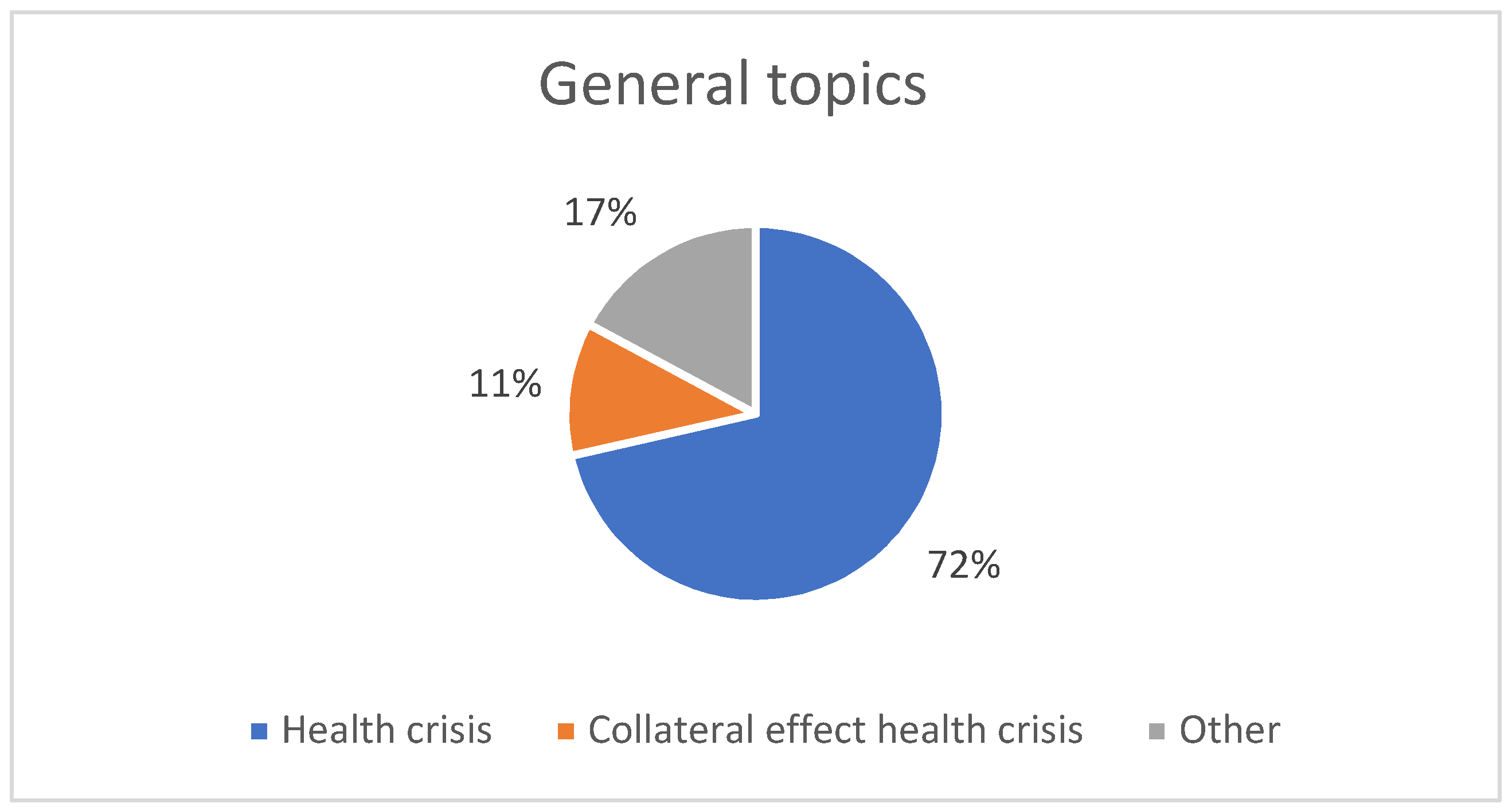
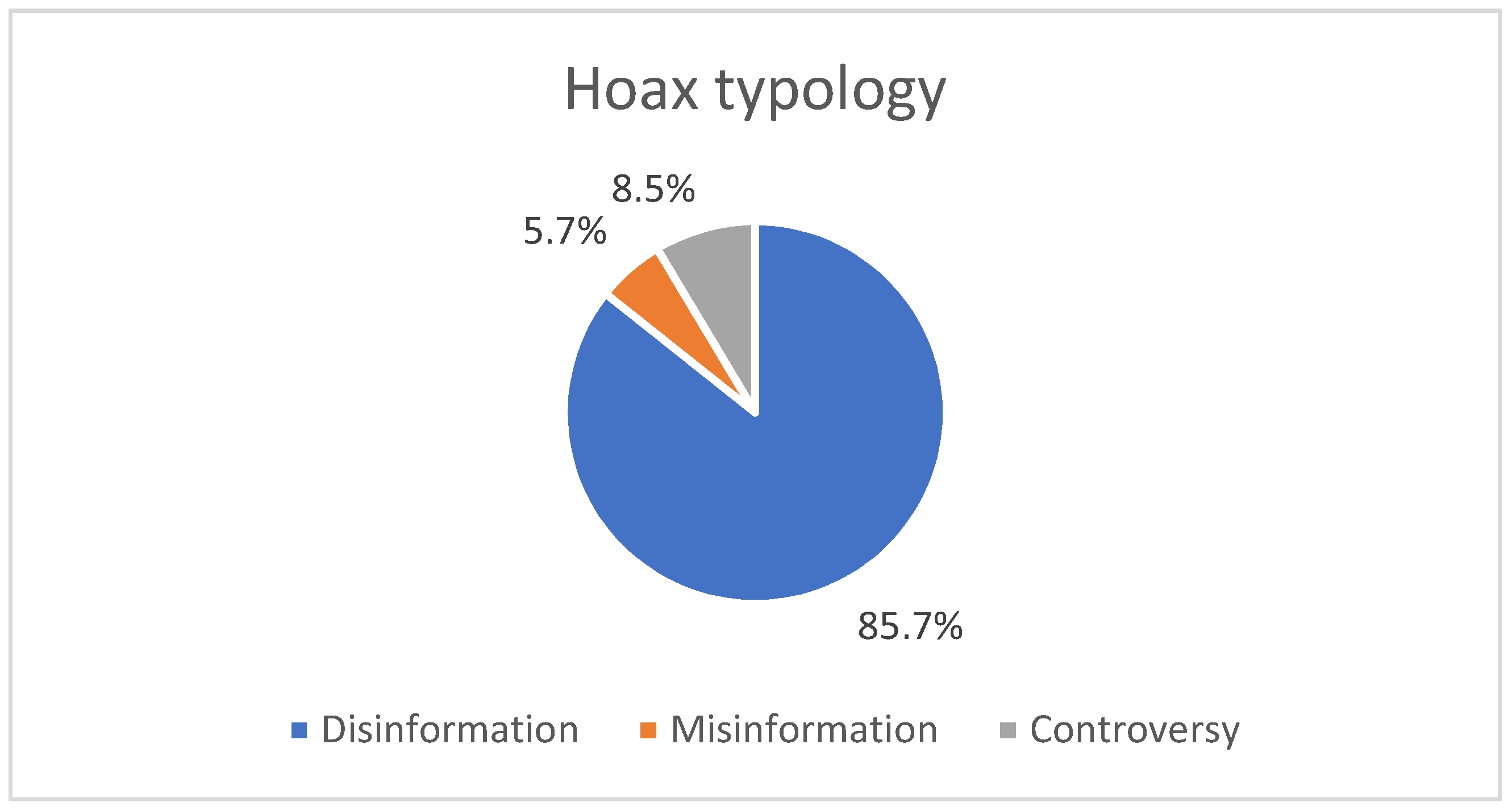

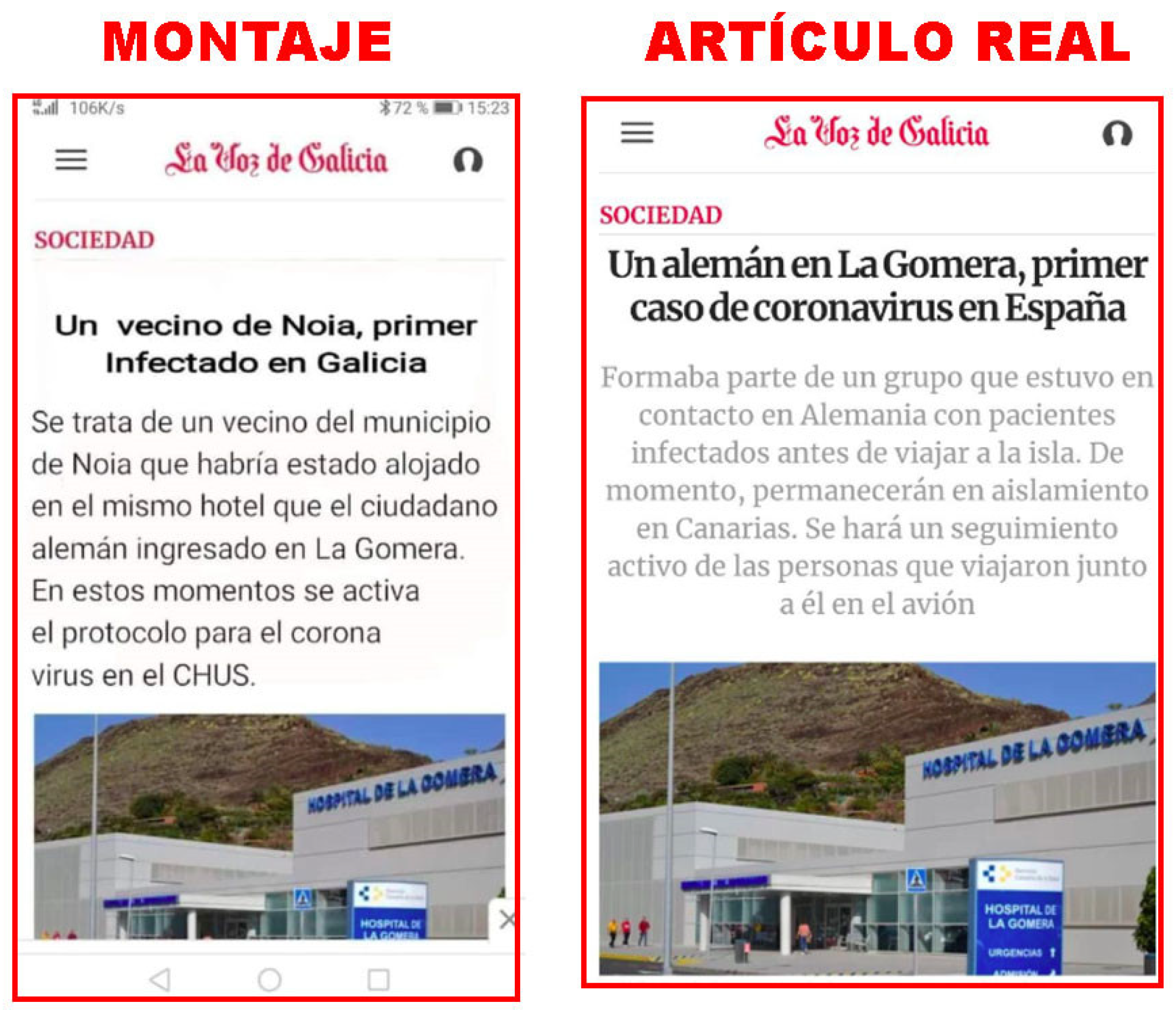


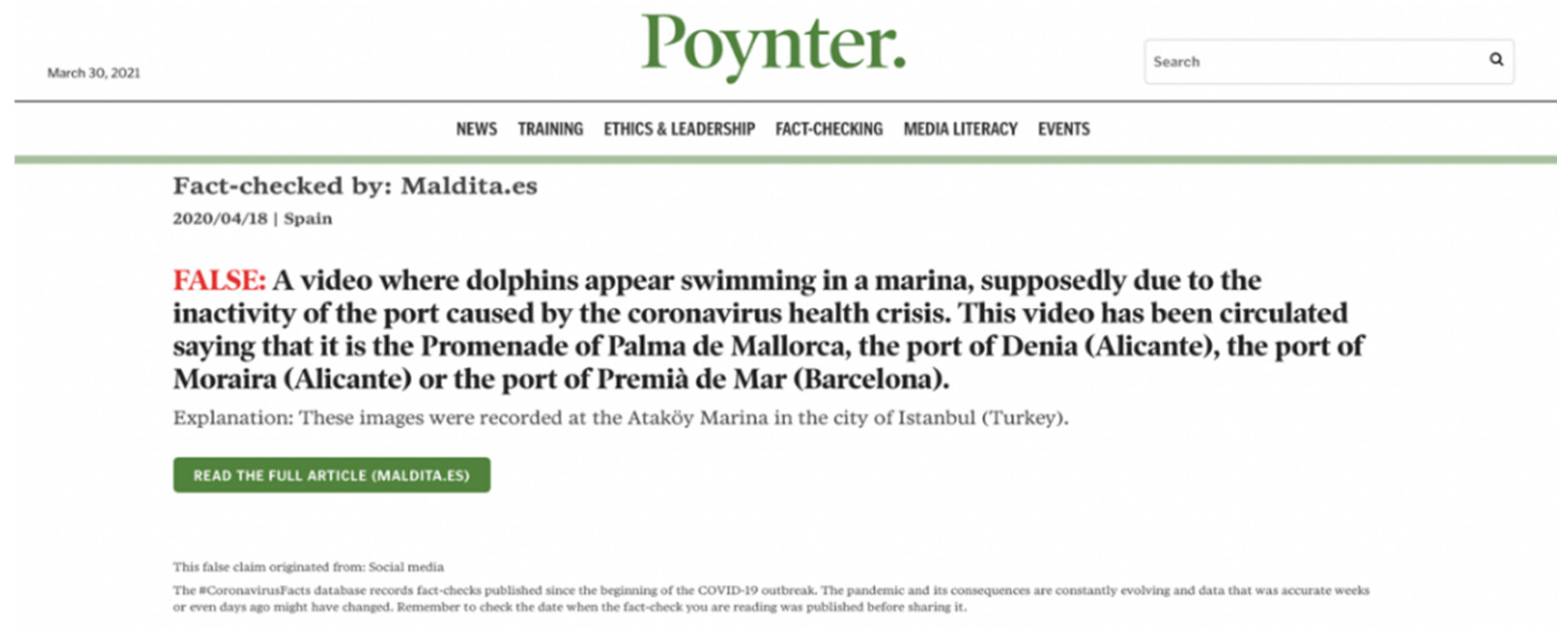
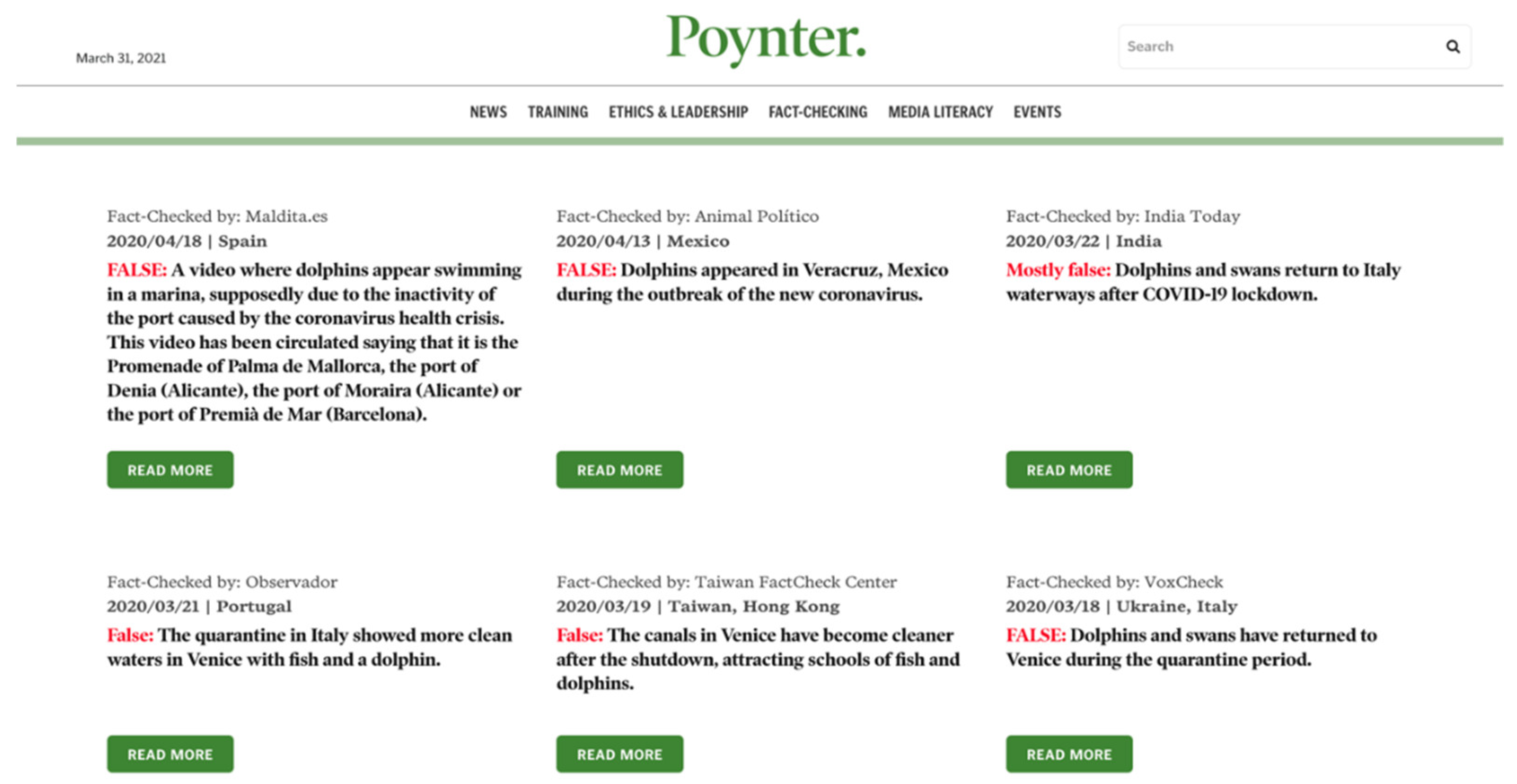
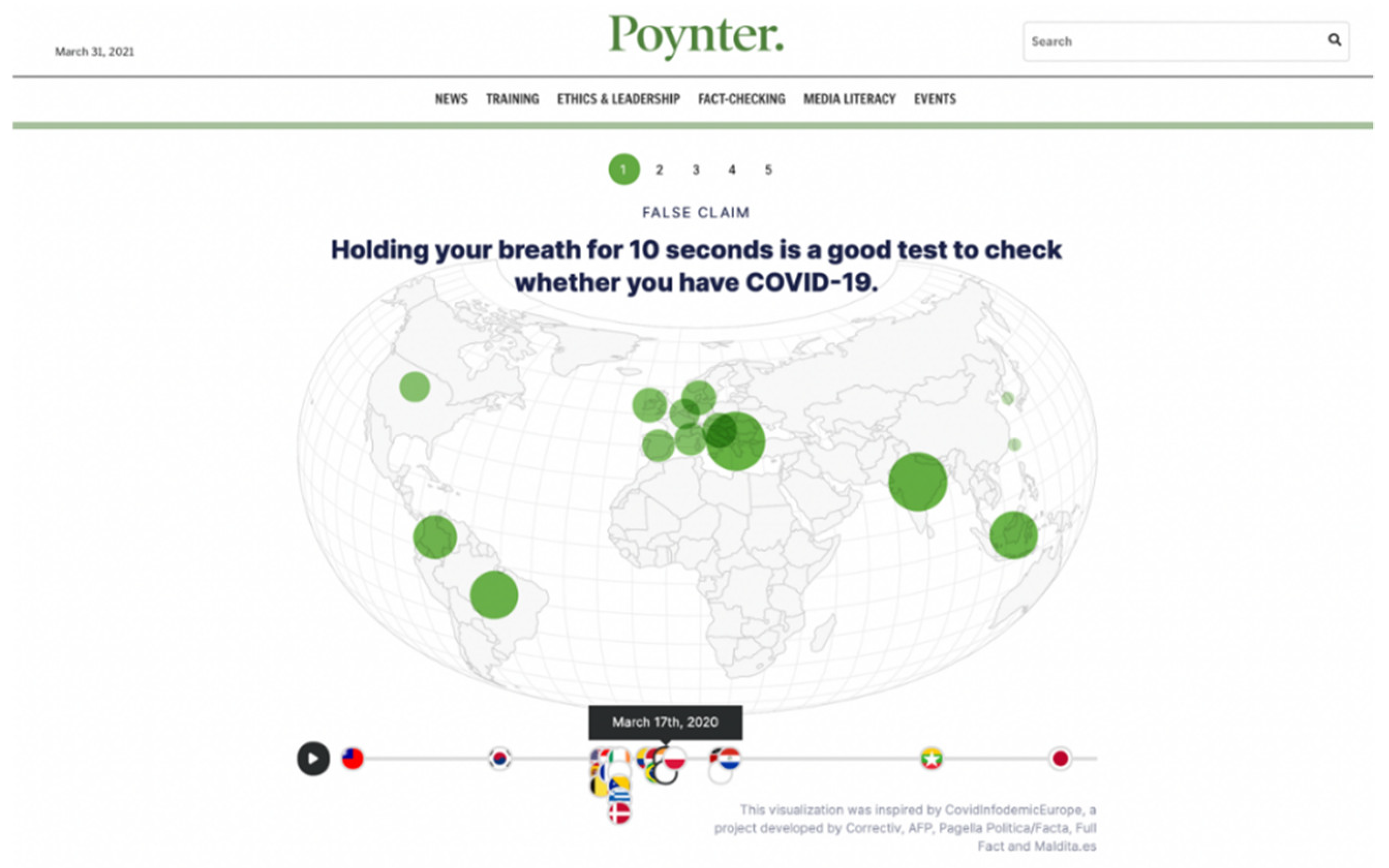
| ID | Hoax Date | Town | Topic and Link to Denial | Typology | Clone Degree | Medium | Memetics |
|---|---|---|---|---|---|---|---|
| #1 | 4/2/2020 | San Vicente | Health Crisis | D | High | Social media | Yes |
| #2 | 19/2/2020 | Alicante | Collateral Effects | D | Low | Social media | No |
| #3 | 2/3/2020 | Elche | Health Crisis | D | Low | Social media (WhatsApp) | No |
| #4 | 11/3/2020 | Teulada | Health Crisis | D | High | Social media | Yes |
| #5 | 13/3/2020 | Elche | Health Crisis | D | High | Social media | Yes |
| #6 | 13/3/2020 | Crevillente | Health Crisis | D | Medium | Social media | No |
| #7 | 15/3/2020 | Alcoy | Health Crisis | D | High | Social media | No |
| #8 | 22/3/2020 | Denia | Health Crisis | D | Medium | Social media | No |
| #9 | 22/3/2020 | Petrel | Health Crisis | D | Medium | Social media | No |
| #10 | 3/4/2020 | Jávea | Health Crisis | D | Medium | Traditional News Media (Press) | No |
| #11 | 9/4/2020 | Torrevieja | Health Crisis | D | Low | Social media | No |
| #12 | 18/4/2020 | Denia/Moraira | Collateral Effects | D | High | Social media | Yes |
| #13 | 21/4/2020 | Alicante | Collateral Effects | D | Medium | Social media | No |
| #14 | 26/4/2020 | Alcoy | Health Crisis | D | High | Social media | Yes |
| #15 | 28/4/2020 | Alicante | Other | C | - | Traditional News Media (Press) | No |
| #16 | 14/5/2020 | Alicante | Health Crisis | C | - | Social media | No |
| #17 | 8/6/2020 | Santa Pola | Other | D | Low | Social media | No |
| #18 | 10/6/2020 | Santa Pola | Other | C | - | Social media, Other | No |
| #19 | 3/7/2020 | Benidorm | Other | D | Low | Social media (Facebook) | No |
| #20 | 7/7/2020 | Torrevieja | Health Crisis | D | High | Social media (Instagram) | Yes |
| #21 | 9/7/2020 | Santa Pola | Health Crisis | D | Low | Social media | No |
| #22 | 14/7/2020 | Santa Pola | Health Crisis | D | Low | Social media | No |
| #23 | 24/7/2020 | San Juan | Health Crisis | M | - | Official source | No |
| #24 | 29/7/2020 | Orihuela | Health Crisis | D | High | Social media | Yes |
| #25 | 29/7/2020 | Calpe | Health Crisis | D | Medium | Social media | No |
| #26 | 5/8/2020 | Benidorm | Other | D | Medium | Social media (Twitter) | No |
| #27 | 24/8/2020 | Novelda | Health Crisis | D | High | Social media | Yes |
| #28 | 1/10/2020 | Torrevieja | Health Crisis | D | Low | Social media | No |
| #29 | 26/10/2020 | Villena | Health Crisis | D | Medium | Social media (WhatsApp) | No |
| #30 | 04/11/2020 | Alicante | Health Crisis | M | - | Official municipal source | No |
| #31 | 8/1/2021 | DENIA | HEALTH CRISIS | D | High | Social media | Yes |
| #32 | 9/1/2021 | ALCOY | OTHER | D | High | Social media | Yes |
| #33 | 16/1/2021 | VILLENA | HEALTH CRISIS | D | High | Social media | Yes |
| #34 | 23/1/2021 | Elche | Health Crisis | D | Low | Traditional News Media (TV) | No |
| #35 | 30/1/2021 | Orihuela | Collateral Effects | D | Low | Blog | No |
| ID | Date and LINK | Town | Theme | Longevity (Outside the Sample) | Fecundity (Within the Local Sample) | Fecundity (Outside the Local Sample) | Copying-Fidelity |
|---|---|---|---|---|---|---|---|
| #1 | 4/2/2020 | San Vicente | Health Crisis (first case in town) | X | X | X | |
| #4 | 11/3/2020 | Teulada | Health Crisis (first case in town) | X | X | X | |
| #5 | 13/3/2020 | Elche | Health Crisis (school closure) | X | X | X | |
| #12 | 18/4/2020 | Denia/Moraira | Collateral Effects (dolphin watching) | X | X | X | |
| #13 | 21/4/2020 | Alicante | Collateral Effects (elderly people robbed) | X | X | X | |
| #14 | 26/4/2020 | Alcoy | Health Crisis (perimeter closure of town) | X | X | X | |
| #20 | 7/7/2020 | Torrevieja | Health Crisis (local bars closed due to outbreak) | X | X | X | |
| #24 | 29/7/2020 | Orihuela | Health Crisis (local bars closed due to outbreak) | X | X | X | |
| #26 | 5/8/2020 | Benidorm | Other (Kidnapping) | X | X | X | |
| #27 | 24/8/2020 | Novelda | Health Crisis (local bars closed due to outbreak) | X | X | X | |
| #31 | 8/1/2021 | Denia | Health Crisis (perimeter closure of town) | X | X | X | |
| #32 | 9/1/2021 | Alcoy | Other (Yellowstone Wolf’s grandparents) | X | X | ||
| #33 | 16/1/2021 | Villena | Health Crisis (school closure) | X | X | X |
| Plot | N° of Cases | Localities |
|---|---|---|
| The report of the first case of coronavirus in the locality or region | 2 | San Vicente del Raspeig and Teulada |
| Dolphin sightings in the marinas of several cities as a result of the emergence of wildlife due to locking down most of the world population | 2 | Denia and Moraira |
| The perimeter closure of localities due to the high incidence of the virus | 2 | Alcoy and Denia |
| The closure of discos because of infections between staff and customers | 3 | Torrevieja, Orihuela, Novelda |
| Closure of educational centres | 2 | Elche and Villena |
| Level | Description | Traits | Examples |
|---|---|---|---|
| High | The contents (obligatory) and if applicable the form and stance of the hoax (optional) expanded inside the local sample and outside it also to other distant geographical localities. | Very High Fecundity High Copying/Fidelity Indeterminate Longevity | Dolphin watching 1st case in town Town Lockdown Facility Lockdown |
| Medium | The contents are similar to others registered in other localities outside the sample, although less strict in terms of form, stance and dates of appearance. | Content Medium Fecundity Medium Copying-Fidelity High Longevity | Fake zombies, which adhere to urban legends periodically revived: kidnappings, theft, swindling |
| Low | The local hoax refers to a highly specific local circumstance, which is related to unique events, facilities or very specific people. | Event with a strong local mark in a close narrative: Elche (#3), Orihuela (#35) |
Publisher’s Note: MDPI stays neutral with regard to jurisdictional claims in published maps and institutional affiliations. |
© 2021 by the authors. Licensee MDPI, Basel, Switzerland. This article is an open access article distributed under the terms and conditions of the Creative Commons Attribution (CC BY) license (https://creativecommons.org/licenses/by/4.0/).
Share and Cite
Rodríguez-Ferrándiz, R.; Sánchez-Olmos, C.; Hidalgo-Marí, T.; Saquete-Boro, E. Memetics of Deception: Spreading Local Meme Hoaxes during COVID-19 1st Year. Future Internet 2021, 13, 152. https://doi.org/10.3390/fi13060152
Rodríguez-Ferrándiz R, Sánchez-Olmos C, Hidalgo-Marí T, Saquete-Boro E. Memetics of Deception: Spreading Local Meme Hoaxes during COVID-19 1st Year. Future Internet. 2021; 13(6):152. https://doi.org/10.3390/fi13060152
Chicago/Turabian StyleRodríguez-Ferrándiz, Raúl, Cande Sánchez-Olmos, Tatiana Hidalgo-Marí, and Estela Saquete-Boro. 2021. "Memetics of Deception: Spreading Local Meme Hoaxes during COVID-19 1st Year" Future Internet 13, no. 6: 152. https://doi.org/10.3390/fi13060152
APA StyleRodríguez-Ferrándiz, R., Sánchez-Olmos, C., Hidalgo-Marí, T., & Saquete-Boro, E. (2021). Memetics of Deception: Spreading Local Meme Hoaxes during COVID-19 1st Year. Future Internet, 13(6), 152. https://doi.org/10.3390/fi13060152






